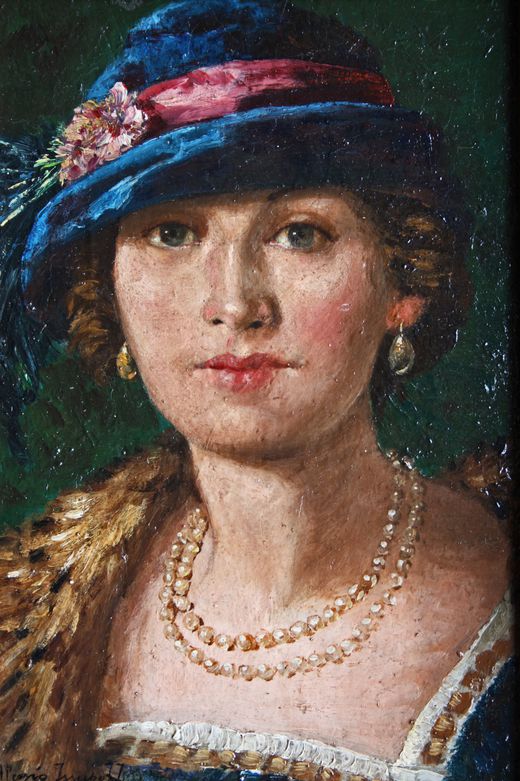

Russian Federation
• 1889
Biography
Biography Alexei Vladimirovich Isupov, known as the Italianate Alessio Issupoff, was born in Vyatka (today Kirov) on March 10, 1889. The son of a sculptor and gilder of icons, he learned to paint from artisan painters who worked with his father. Wanting to express his artistic creativity, the young Alessio did not exercise the fatherly profession but left Vjatka for Moscow, where he attended the school of painting, sculpture and architecture. He was supervised by the painter Apollinarij Michajlovic Vasnetsov, brother of Viktor, who introduced him to the Moscow artistic milieu and helped him find work. Student and visiting museums, Issupoff formed his aesthetic "taste" by modulating it on contemporary Russian and French art. Besides Vasnetsov, Valentin Serov and Konstantin Korovin taught him genre painting, landscape painting and portraiture. After graduating in 1912, he traveled to the Urals region. Assigned to the Tashkent garrison, he avoided the harsh experience of the First World War. After his military service, he went to Turkestan immersing himself in a colorful and "magical" environment which would have strongly marked his painting. In fact, many of his most famous works offer suggestive visions of the most remote countries of Central Asia. Having settled in Samarkand with his wife Tamara Nikolaevna, he served as director of the local committee for the restoration and conservation of works of art and monuments. He then perfected the technique of tempera on a wooden panel, creating works that, in their style, refer to traditional icon painting. His return to Moscow in 1921 marked the beginning of the most painful period in his private life. Finding himself in a difficult economic situation, Issupoff was reduced to becoming the artist of the "regime", or to painting portraits of senior Soviet leaders and scenes inspired by the Russian Revolution and the Red Army. Once again, it was Vasnetsov who helped him, finding him paid employment in one of the many committees in Moscow. Suffering from health problems, he went to Italy in 1926 for treatment. His life then underwent a radical change. Italy was the place of his personal and artistic rebirth. Issupoff immediately found a warm and flattering reception. Since his arrival, he has had the opportunity to be appreciated by critics and the public. Already in 1926, his first solo exhibition was organized in Rome. Many other exhibitions followed in the most important cities of the peninsula and, in 1930, at the XVII Venice Biennale. He "dedicated" the work of the Russian painter. Taking advantage of the esteem, comfort and freedom of expression, the artist decided not to return to his country. Issupoff's production itself shows just how painful that decision had been. Painting "by heart", he recreated the Russia he had left behind. Not that of the USSR, but that of before the revolution which he had known in his childhood and his youth. "The impressions he has of his country come back to the new paintings with a greater richness of patterns and the scale of the deployment: the misty moors, the rivers which crisscross, the cold and the darkness, the snowy countryside, the birches who embroider their silver strike between the veils of fog, and grazing horses, sleigh, troika, plow. ”[1] Nostalgia, combined with unstable health, exacerbated the depression that struck him in his old age, making him hide in his own house and isolate him from the world. According to his wife Tamara [2], in recent years he has painted very little and never attended the inauguration of the exhibitions dedicated to him. died in Rome on July 17, 1957 and was buried in the cemetery of Testaccio. Nine years later, Tamara returned to Russia with the paintings inherited from her husband. She donated many of these works to the Vjatka Art Museum , Issupoff's birthplace Themes, styles and orientations I ssupoff mainly painted places and faces from his home country. When he depicted an Italian peasant woman, his hand drew a face with Slavic features, while the small countryside of central Italy, on his canvas, became a corner of boundless Russia. The female figure, the genre scene and the landscape were his favorite themes. Considering the frequency with which they appear in his works, it can be said that he was very fond of horses. "The horses of the Issupoff" writes Giorgio Nicodemi [3] "are not those of elegant meetings (...) are those of peasants or small Russian owners, attached to carriages or ridden by people who know how to stay courageously ". Issupoff could have been described as a "young man" Orientalist painter ", whereas at the age of maturity, he was mainly portrait painter and landscape painter. The broad line and the supremacy given to the color (instead of the drawing) express his will to emphasize the spirit rather than the form of things. This is evident in some scenes painted with such elementary lines bordering on sketching. So it would seem that the living subjectivity of the artist Issupoff prevails on the "objective" world. He must therefore "figure among the masters who drew from Impressionism the standard of open and breathing painting of light" [4].
Read more
Nationality
Exhibitions dedicated to Alessio Issupoff
Discover the movements linked to Alessio Issupoff
Discover our selections of works by artists
Need help finding your favorite? Consult our selection pages made for you.
Need to know more?
When was Alessio Issupoff born?
The year of birth of the artist is: 1889





